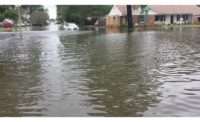The coast of Louisiana is sinking, drowning and being blown away at a rate that exceeds any other coastline in the United States. The state accounts for 40% of the nation’s wetlands but 80% of its wetland losses.
 Since 1932, the state has lost about 1,900 sq miles of land—about the land area of Delaware—and its latest predictions put additional losses in the range of 1,800 to 4,200 sq miles over the next 50 years.
Since 1932, the state has lost about 1,900 sq miles of land—about the land area of Delaware—and its latest predictions put additional losses in the range of 1,800 to 4,200 sq miles over the next 50 years.
“The coast is actively falling apart,” says Denise Reed, chief scientist at The Water Institute of the Gulf.
But with money from the BP oil-spill settlement, Louisiana is putting into place a $50-billion coastal master plan to help, if not completely stop, the loss of land. While the projects’ first aim is to reconstruct what has been lost, the plans also include rebuilding and elevating the barrier islands, berms and wetlands because of anticipated sea-level rise.
The biggest project is the $2.4-billion Mississippi River Mid-Basins Sediment Diversions Program, which will result in the construction of two sediment diversions: the Mid-Barataria and the Mid-Breton. These diversions will reintroduce the river’s natural process in which silt is captured and deposited into basins to build and maintain land.
Each diversion is being treated as a separate project, with Mid-Barataria currently several years ahead of Mid-Breton. The state hopes to start construction on Mid-Barataria by 2020.
Among the projects’ challenges is the construction of an engineered gated control structure in the Mississippi River levee, a 2.5-mile conveyance channel and back structure that feeds into the basin, says Brad Barth, program manager at Coastal Protection and Restoration Authority (CPRA).
Both diversions will be delivered using CM-at-risk, and this will be one of the first and largest projects to use CMAR in Louisiana’s history, according to the agency. Each project will have three phases: regulatory and permitting process, engineering and design, and construction. The U.S. Army Corps of Engineers will also oversee construction.
LOUISIANA Tulane University researchers recently showed that, due to subsidence, the amount of relative sea-level rise over the past six to 10 years is about half an inch a year.
Since environmental impacts must be considered, per the National Environmental Policy Act, an environmental impact statement (EIS) is being conducted through 2017.
The permitting process is already underway for Mid-Barataria, with the USACE holding public scoping meetings in late July to solicit feedback on the project, Barth says. CPRA issued a request for information in March and received qualifications in April; a contractor will be selected in the coming weeks, Barth notes. Engineering has started and is running concurrently with permitting.
Meanwhile, Mid-Breton is in the early stages of implementation. CPRA anticipates soliciting and hiring the engineering and design team by the second quarter of 2018, Barth adds.
“Across the entire program, approximately 40 different procurements will occur,” notes Josh Crowe, manager of the program management office at CH2M. Anticipated contract amounts range from tens of thousands to tens of millions of dollars, Crowe notes. The procurement process is moving ahead, with solicitations and selections for the Mid-Barataria E&D and CMAR.
The next major procurements will be the Mid-Barataria independent cost estimating and Mid-Breton E&D, Crowe says. The procurement process will continue for two years.
Although specific project design criteria have not yet been established, CPRA expects both diversions will be designed to operate for at least 50 to 100 years, with service life expected to exceed design life, Barth explains. The grand vision places equal emphasis on all stages of the project: operations, maintenance, repair, rehabilitation and replacement.
Sea-level rise and subsidence are being incorporated into the basin-wide modeling efforts during the E&D phase, Barth says.
While the short-term focus remains on Mid-Barataria and Mid-Breton, these are just the start, explains Rudy Simoneaux, CPRA’s deputy program manager. “There are 11 different sediment-diversion projects [planned] on the Mississippi and Atchafalaya Rivers, with total expected costs of just over $5 billion. Our analysis indicates we need to put the river back to work,” he says.




Post a comment to this article
Report Abusive Comment